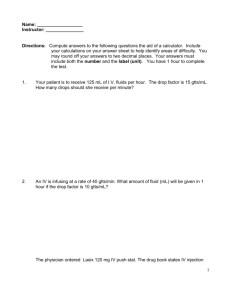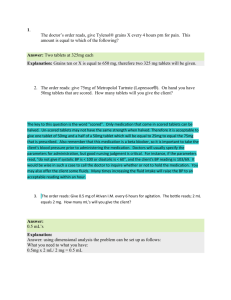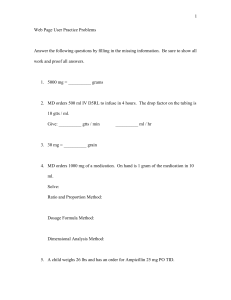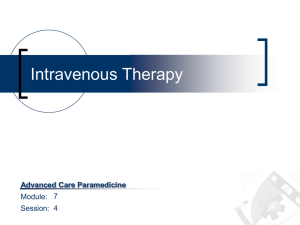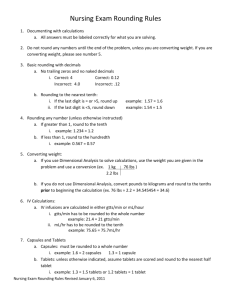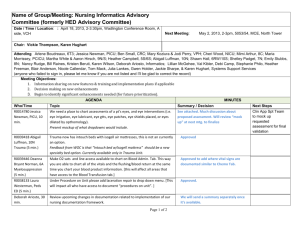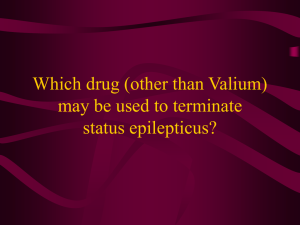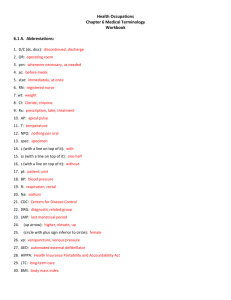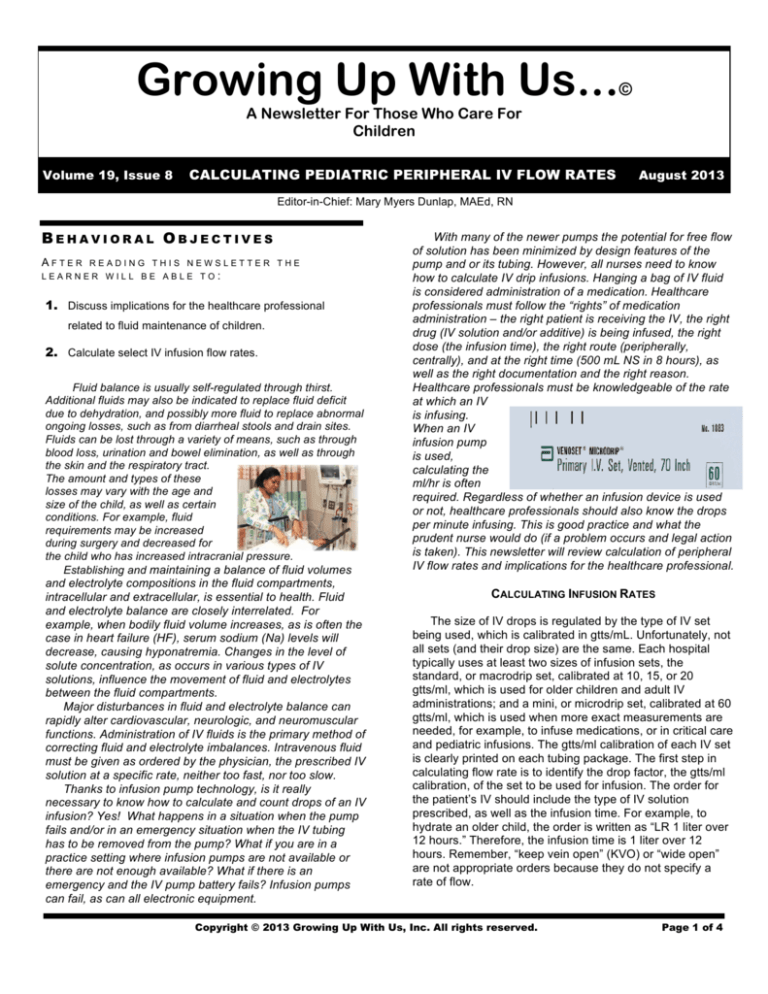
Growing Up With Us...
©
A Newsletter For Those Who Care For
Children
Volume 19, Issue 8
CALCULATING PEDIATRIC PERIPHERAL IV FLOW RATES
August 2013
Editor-in-Chief: Mary Myers Dunlap, MAEd, RN
BEHAVIORAL OBJECTIVES
AFTER
READING THIS NEWSLETTER THE
LEARNER WILL BE ABLE TO:
1. Discuss implications for the healthcare professional
related to fluid maintenance of children.
2. Calculate select IV infusion flow rates.
Fluid balance is usually self-regulated through thirst.
Additional fluids may also be indicated to replace fluid deficit
due to dehydration, and possibly more fluid to replace abnormal
ongoing losses, such as from diarrheal stools and drain sites.
Fluids can be lost through a variety of means, such as through
blood loss, urination and bowel elimination, as well as through
the skin and the respiratory tract.
The amount and types of these
losses may vary with the age and
size of the child, as well as certain
conditions. For example, fluid
requirements may be increased
during surgery and decreased for
the child who has increased intracranial pressure.
Establishing and maintaining a balance of fluid volumes
and electrolyte compositions in the fluid compartments,
intracellular and extracellular, is essential to health. Fluid
and electrolyte balance are closely interrelated. For
example, when bodily fluid volume increases, as is often the
case in heart failure (HF), serum sodium (Na) levels will
decrease, causing hyponatremia. Changes in the level of
solute concentration, as occurs in various types of IV
solutions, influence the movement of fluid and electrolytes
between the fluid compartments.
Major disturbances in fluid and electrolyte balance can
rapidly alter cardiovascular, neurologic, and neuromuscular
functions. Administration of IV fluids is the primary method of
correcting fluid and electrolyte imbalances. Intravenous fluid
must be given as ordered by the physician, the prescribed IV
solution at a specific rate, neither too fast, nor too slow.
Thanks to infusion pump technology, is it really
necessary to know how to calculate and count drops of an IV
infusion? Yes! What happens in a situation when the pump
fails and/or in an emergency situation when the IV tubing
has to be removed from the pump? What if you are in a
practice setting where infusion pumps are not available or
there are not enough available? What if there is an
emergency and the IV pump battery fails? Infusion pumps
can fail, as can all electronic equipment.
With many of the newer pumps the potential for free flow
of solution has been minimized by design features of the
pump and or its tubing. However, all nurses need to know
how to calculate IV drip infusions. Hanging a bag of IV fluid
is considered administration of a medication. Healthcare
professionals must follow the “rights” of medication
administration – the right patient is receiving the IV, the right
drug (IV solution and/or additive) is being infused, the right
dose (the infusion time), the right route (peripherally,
centrally), and at the right time (500 mL NS in 8 hours), as
well as the right documentation and the right reason.
Healthcare professionals must be knowledgeable of the rate
at which an IV
is infusing.
When an IV
infusion pump
is used,
calculating the
ml/hr is often
required. Regardless of whether an infusion device is used
or not, healthcare professionals should also know the drops
per minute infusing. This is good practice and what the
prudent nurse would do (if a problem occurs and legal action
is taken). This newsletter will review calculation of peripheral
IV flow rates and implications for the healthcare professional.
CALCULATING INFUSION RATES
The size of IV drops is regulated by the type of IV set
being used, which is calibrated in gtts/mL. Unfortunately, not
all sets (and their drop size) are the same. Each hospital
typically uses at least two sizes of infusion sets, the
standard, or macrodrip set, calibrated at 10, 15, or 20
gtts/ml, which is used for older children and adult IV
administrations; and a mini, or microdrip set, calibrated at 60
gtts/ml, which is used when more exact measurements are
needed, for example, to infuse medications, or in critical care
and pediatric infusions. The gtts/ml calibration of each IV set
is clearly printed on each tubing package. The first step in
calculating flow rate is to identify the drop factor, the gtts/ml
calibration, of the set to be used for infusion. The order for
the patient’s IV should include the type of IV solution
prescribed, as well as the infusion time. For example, to
hydrate an older child, the order is written as “LR 1 liter over
12 hours.” Therefore, the infusion time is 1 liter over 12
hours. Remember, “keep vein open” (KVO) or “wide open”
are not appropriate orders because they do not specify a
rate of flow.
Copyright © 2013 Growing Up With Us, Inc. All rights reserved.
Page 1 of 4
The specific rate may be measured as ml/hour or drops/min.
To control or adjust the flow rate only drops per minute are
used. To calculate the flow rate, one formula is as follows:
Volume (total) x Drop factor (gtts/ml) = Flow rate (gtts/min)
Time (in minutes)
Volume (ml/hr) x Drop factor (gtts/ml) = Flow rate (gtts/min)
60
Example
1000 ml IV D5W is ordered over 12 hours
using regular tubing (15 gtts/ml). How many
drops per minute are needed to be delivered?
LR 1 liter is ordered over 12
hours using regular tubing
(15 gtts/ml). How many drops per minute
should be delivered? Using the formula
above:
1000 ml ÷ 12 (ml/hr) x 15 gtts/ml = Flow rate (gtts/min)
60
1000 (total volume) x 15 gtts/ml = Flow rate (gtts/min)
720 (12 x60)
Let’s try a calculation using a mini-dropper (60 gtts/ml) with
this formula:
1000 x 15 = 15000 = 20.83 (21) gtts/min
720
Volume (ml/hr) x Drop factor (gtts/ml) = Flow rate (gtts/min)
60
This formula is useful when small-volume flow rates are
used.
An IV medication of 100 ml is to be infused
Example
in 40 min using a set calibrated at 15
gtts/mL. What is the flow rate?
1 liter of LR is to be infused at 30 ml per
hour. The IV set delivers 60 gtts/ml. What is
the correct rate of flow?
Example
Calculate the gtts/min to be infused:
100 (total volume) x 15 gtts/mL = Flow rate (gtts/min)
40
100 x 15 = 1500 = 37.5 (38) gtts/min
40
The answer can also be obtained by using ratios and
proportions:
100 mL:40 min = X mL:1 min (100 mL = X mL = 100 x 40x = 2.5
40 min 1 min
83 x 15 = 1245 = 20.7 (21) gtts/min
60
Example
30 (ml/hr) x 60 gtts/ml = 30 gtts/min
60
Let’s try another calculation using tubing that delivers 10
gtts/ml.
The order reads: “Over the next 4 hours, infuse 200 ml of
D5W.” The set is calibrated to deliver 20
Example
gtts/ml. In drops per minute, what is the flow
rate?
Volume (ml/hr) x Drop factor (gtts/ml) = Flow rate (gtts/min)
60
200 ÷ 4 (ml/hr) x 20 gtts/ml = Flow rate (gtts/min)
60
The set delivers 15 gtt/mL. 2.5 mL x 15 = 37.5 gtts/min
Let’s try a calculation using tubing that delivers 10 gtts/ml.
The order reads: “Over the next 4 hours,
infuse 500 ml D5W. Add 20 MEq of KCL to
solution. In drops per minute, what is the flow rate? Note: In
this example, the KCL adds minimal volume and doesn’t
need to be considered in your calculation of the flow rate.
Example
Volume (total) x Drop factor (gtts/ml) = Flow rate (gtts/min)
Time (in minutes)
500 ml (volume) x 10 (gtts/ml) = Flow rate (gtts/min)
60 x 4 = 240 (minutes)
5000 = 20.8 (21) gtts/min
240
When an IV is ordered to infuse in more than 1 hour, this
formula can still be used. However, to keep the numbers you
are working with as small as possible, it is best to add a
preliminary step and determine the ml/hr the ordered volume
will represent. 60 will be the denominator, since there are 60
minutes in an hour.
50 x 20 = 1000 = 16.6 (17) gtts/min
60
Regulating IV fluid is an ongoing process from the time
that an IV infusion is started until it is completed. Depending
on the facility's guidelines and
patient condition, hourly checks of
an IV should include assessing and
documenting the IV flow rate, the IV
site, the patient’s response to the
IV, how much fluid has infused, and
how much fluid remains to be
infused.
An upcoming newsletter will discuss types of IV solutions
with related nursing implications, as well as assessment of
fluid overload and fluid deficit.
Growing Up With Us, Inc.
PO Box 481810 • Charlotte, NC • 28269
GUWU Testing Center
www.growingupwithus.com/quiztaker/
Phone: (919) 489-1238 Fax: (919) 321-0789
Editor-in-Chief: Mary M. Dunlap MAEd, RN
E-mail: editor@growingupwithus.com
Website: www.growingupwithus.com
Copyright © 2013 Growing Up With Us, Inc. All rights reserved.
Page 2 of 4
Name:_____________________________________________________
Date:___________________________________
Employee ID#:____________________________________________
Unit:____________________________________
POPULATION/AGE-SPECIFIC EDUCATION POST TEST
GROWING UP WITH US... Caring For Children August 2013 Competency: Demonstrates Age-Specific Competency by correctly answering 9 out of
10 questions related to Calculating Pediatric Peripheral IV Flow Rates.
CALCULATING PEDIATRIC PERIPHERAL IV FLOW RATES
1. The prudent pediatric nurse does not need to calculate the flow rate, in gtts/min, if an infusion pump is
being used.
a. True
b. False
2. Changes in the level of solute concentration, as occurs in various types of IV solutions, influence the
movement of fluid and electrolytes between the fluid compartments.
a. True
b. False
3. Identify the calibration in gtts/mL on this IV tubing package.
a.
b.
c.
d.
more information is needed.
15
60
70
4. An IV of 150 mL is to infuse in 1 hr using a set calibrated at 60 gtts/mL. How many gtts/min is the flow
rate?
a.
b.
c.
d.
15
25
38
150
5. An IV of 1000 mL is ordered to infuse in 5 hrs using a set calibrated at 10 gtts/mL. How many gtts /
min should infuse?
a.
b.
c.
d.
8
33
83
200
Copyright © 2013 Growing Up With Us, Inc. All rights reserved.
Page 3 of 4
Name:_____________________________________________________
Date:___________________________________
Employee ID#:____________________________________________
Unit:____________________________________
POPULATION/AGE-SPECIFIC EDUCATION POST TEST
GROWING UP WITH US... Caring For Children CALCULATING PEDIATRIC PERIPHEAL IV FLOW RATES
6. Over the next 4 hours, 500 ml of D5W with 20 MEq KCL is to be infused using tubing that delivers 15
gtts/ml. What is the flow rate?
a.
b.
c.
d.
20
31
38
125
7. The above IV infusion was started at 9:30 a.m. If the fluid is infusing as ordered, at 11:30 a.m, 250 mL
should remain to be infused.
a. True
b. False
8. An IV medication of 60 ml is ordered to infuse in 30 min. The set calibration is 20 gtts/mL. Calculate
the gtts/min flow rate.
a.
b.
c.
d.
3
20
30
40
9. 75 mL of a medication is to be administered in 50 min using a set calibrated at 10 gtts/mL. How many
gtts/min will infuse?
a.
b.
c.
d.
13
15
30
38
10. An IV order written as “KVO” as well as, “wide open”, doesn’t specify the flow rate and should,
therefore, not be carried out until there is clarification of the specific flow rate from the ordering
physician.
a. True
b. False
Copyright © 2013 Growing Up With Us, Inc. All rights reserved.
Page 4 of 4

